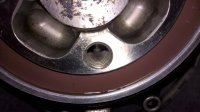iainw
Cruisin' Guzzisti
The parts I used were
Carc large bearing SKF 61917 85x120x18mm
Seal 85x110x10 R23 Viton
I'm still not convinced that the C3 bearing is the correct application for a Guzzi CARC. Some of the articles suggest my line of thought could be correct.
A C3 is often stated to be used on an electric motor running at high speed where heat is transmitted though the shaft to the bearing and there would also be the heat generated by the bearing itself adding to the expansion of the bearing components. Constant high temp applications with only rotational forces.
In the CARC there is no heat transmitted to the bearing from the shaft, that's bolted to the wheel, the unit is a long way from the engine, and the oil it's running in is splashed against the casing and cooled, unlike grease. When I've changed the CARC oil I've ridden the bike for 20 minutes or so to get it up to temp for the drain, the CARC oil that comes out is not hot, it's warm, but not what could be called high temp, engine oil, yes. The speed it's running at is low compared to what might be termed a high speed motor. So it's a cooler application not requiring the greater clearance of a C3.
References to C3 usage in gearboxes are not referring to rear differentials on a motorcycle where the CARC bearings are subject to other forces when the bike goes round bends, any additional clearance is going to accelerate wear under these stresses. The CARC bearing is also a wheel bearing.
My bearing failed at 25k miles and was a C3, others were also failing, many before this sort of mileage. Based on the above I reckon a normal clearance bearing is the one for this application and my question was for people to have a look at the failed bearings they take out. It's probably a bit late now as the main failures have probably all been replaced and the opportunity has been missed. Also what have they been replaced with, a C3 or normal?
I'd be interested to know what Pete Roper uses as replacements, he's probably done more than the rest of us put together.

Cheers,
Iain
Carc large bearing SKF 61917 85x120x18mm
Seal 85x110x10 R23 Viton
I'm still not convinced that the C3 bearing is the correct application for a Guzzi CARC. Some of the articles suggest my line of thought could be correct.
A C3 is often stated to be used on an electric motor running at high speed where heat is transmitted though the shaft to the bearing and there would also be the heat generated by the bearing itself adding to the expansion of the bearing components. Constant high temp applications with only rotational forces.
In the CARC there is no heat transmitted to the bearing from the shaft, that's bolted to the wheel, the unit is a long way from the engine, and the oil it's running in is splashed against the casing and cooled, unlike grease. When I've changed the CARC oil I've ridden the bike for 20 minutes or so to get it up to temp for the drain, the CARC oil that comes out is not hot, it's warm, but not what could be called high temp, engine oil, yes. The speed it's running at is low compared to what might be termed a high speed motor. So it's a cooler application not requiring the greater clearance of a C3.
References to C3 usage in gearboxes are not referring to rear differentials on a motorcycle where the CARC bearings are subject to other forces when the bike goes round bends, any additional clearance is going to accelerate wear under these stresses. The CARC bearing is also a wheel bearing.
My bearing failed at 25k miles and was a C3, others were also failing, many before this sort of mileage. Based on the above I reckon a normal clearance bearing is the one for this application and my question was for people to have a look at the failed bearings they take out. It's probably a bit late now as the main failures have probably all been replaced and the opportunity has been missed. Also what have they been replaced with, a C3 or normal?
I'd be interested to know what Pete Roper uses as replacements, he's probably done more than the rest of us put together.
Cheers,
Iain

